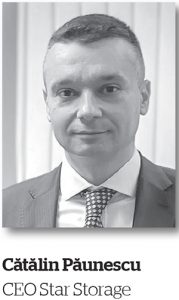For some businesses, digitization can make the difference between prosperity and suffering, says Cătălin Păunescu, CEO of Star Storage. Digitalization and automation are already changing the functioning and the business models of the companies in the energy sector. The trend will intensify in the coming years, and the Romanian expertise will be felt both locally and abroad. Starting from here, we discussed with Cătălin Păunescu about the contribution that companies providing software products and IT services for outsourcing and cloud can make for increased efficiency and performance for companies in the energy industry.
The first wave of computerization of the industry meant the widespread adoption of office solutions, through which the productivity of organizations has increased dramatically in recent decades. What are the new computerization solutions?
 As far as specific business processes are concerned, digitization is the key word. A first category is represented by the departmental processes, which can be found in any company, pertaining to the energy industry or any other sector. I am referring now, as an example, to the administration of the human resources department, the financial department or the legal department. The easiest way to describe what we do is turning processes that depend on paper into digital processes. It is a transformation that has a great impact both on productivity as well as in terms of traceability, which is very important for the compliance with regulatory and reporting obligations. Then, when we talk about digital processes we refer mainly to automation – as little human work as possible and as much work done by software applications, based on rules. People are harder to find, moreover, people can make mistakes and most often they make mistakes.
As far as specific business processes are concerned, digitization is the key word. A first category is represented by the departmental processes, which can be found in any company, pertaining to the energy industry or any other sector. I am referring now, as an example, to the administration of the human resources department, the financial department or the legal department. The easiest way to describe what we do is turning processes that depend on paper into digital processes. It is a transformation that has a great impact both on productivity as well as in terms of traceability, which is very important for the compliance with regulatory and reporting obligations. Then, when we talk about digital processes we refer mainly to automation – as little human work as possible and as much work done by software applications, based on rules. People are harder to find, moreover, people can make mistakes and most often they make mistakes.
There is much talk and work nowadays for the so-called “digital experience” and “digital engagement”. The interaction with the customer is, traditionally, an analogical one, meaning that you have a face to face interaction with the customer. The interaction of the future is a digital one. In this area, digital solutions can fundamentally influence the costs, and the performance is quantified depending on the number of new customers attracted and the degree of differentiation from the competition of energy companies, the more so as in the supply segment we have a free market.
What is the differentiation from competition, IT solutions-wise?
At the first level of differentiation, we see companies that have digitized their processes and companies that continue to work through customer relations centers. There are companies that have adapted to the new technologies and companies that are still dependent on paper and physical counters. Going forward, when all companies would have digitized their processes, the user experience makes a difference, because digital interaction is not always good. I have seen situations with customers who prefer to spend an extra half hour on the road to reach a counter, rather than using a digital system that does not work. In 2019, all users expect an application to work instantly, permanently and without error, as learned from applications like Facebook or Google. We are not only talking about the new generation, our parents already work a lot using the mobile phone, rather than the computer!
Differentiation is, therefore, made depending on the quality of the user interface: how friendly it is, how universal it is (if it looks the same on mobile and computer), how easy it is to use it (how many clicks needed) to solve your problem. Companies that have understood the user experience matter treat it seriously and with good results.
Speaking of technological solutions, what are the news of the moment and what impact do they have on Star Storage’s customers?
Until recently, we were talking about monolithic architectures, and now everything revolves around native applications in cloud, that is micro-services or modular applications that can run in containers, in order to be able to rapidly increase the volume of business that is operated through them. This gives you maximum scalability and flexibility. For example, you have an application with 20 modules or micro-services, and you need to increase, for a very small period, only the part for registering the customers, because you anticipate a peak, following a special offer or a promotion. For that period, a week-two, you can allocate resources for those modules only, which you could not easily do before. Moreover, in the past, computer applications were built for IT people. The suppliers had the buyer in their minds (in general, the IT manager), while everything is now being designed considering the non-IT user, taking into account the democratization of access to computerization. Specifically, the applications must be simple to use and must meet the needs of a non-specialized beneficiary.
Of the operational areas that you mentioned, which are the ones in which Star Storage solutions bring the most important benefits for the customer?
Both areas are very important, so I prefer to talk about the right steps. Most companies start from the front end, in order to attract as many customers, preferably from the competition, as quickly as possible. The reality is that if you attract a lot of customers and you cannot deal with them in the back-end, you risk losing them and getting negative references about the services you provide. It is logical to rethink first your internal processes so that, by digitization, you can prepare for an extra volume of customers, developing additional services and having solid electronic flows. Investing in the front-end is the next step.
How do you work with energy companies? Are they looking for you or do you present the solutions they choose from according to their priorities?
Customers are becoming more educated, and the companies from the energy sector often have strong IT departments, with people specialized in digital strategies, and they are thinking about how they can bring benefits to the whole organization, not just in the IT area. So, we talk to an informed public, who comes with clear ideas and requirements. Of course, we also come up with new ideas or refinements of these requests. For example, a beneficiary needs a digital solution for enrolling new customers. Star Storage can provide technological novelty elements such as video identification, face ID (face identification from a video capture which contains an ID card’s photo). We can propose elements of electronic signature type, automatic generation of electronic documents and application of a qualified, advanced electronic signature, etc. For a customer who wants a custom-developed application, we bring a low-code/no code approach, which allows, by means of parameterization, to reach the desired goal: an already existing platform, which you can map according to the customer ‘s needs. The low code/no code approach versus development from scratch means lower risks and shorter implementation times. In addition, we often use proof-of-concept, proof-of-value or even pilot projects so that the beneficiary can see from the start what answers we can provide to its needs. It is an effort on our part, but the sales cycle is thus reduced, and in terms of sales, we can near the true value of the solution we provide.
How big is the distance of information and understanding between the IT department and the decision-making level of a company?
The level of technological knowledge is much lower at the executive level and it is natural to be so. The ideal scenario for choosing an IT solution is for the beneficiary’s specialized IT team to work with the supplier’s team to present the decision-maker with a necessary package that meets the business needs.
Are things different in the area of medium-sized companies?
Currently, we work with top clients, present in 20 countries on 4 continents, operating in sectors such as banking, insurance, retail, telecom, oil and gas, electricity. In the mid-market segment, the level of technological education available to the beneficiary decreases, as does the level of financial resources. For these potential customers, we have designed some dedicated packages, in which we propose the same level of quality in a cloud delivery model, i.e. infrastructure as a service, software as a service, based on a subscription. It’s a formula very similar to the utility sector model (water, electricity), and we provide the software solution as a utility – pay as you use.
How long does it take to implement the investment for a computerization project proposed by Star Storage?
The implementation should take 3-4 months. Our recommendation is to give up mammoth projects, taking a year or more to develop, in favor of an agile approach, with sprints of several weeks and a total duration of several months. Even a very large program or objective can be segmented, which allows for measuring the achievements and marking each intermediate object. Thus, each time, you start again with enthusiasm, with another vibe and with another understanding gained in the previous steps.
What is the international footprint of Star Storage and how does it contribute to the team’s performance in Romania?
The Star Storage team means 260 people, and our experience grows with each application implemented; expansion on international markets has helped us a lot. We started with the technological partnerships concluded with big global companies such as Hitachi, Microsoft, SAP or SalesForce, and we are along with global integrators who already have well-established relationships with top clients of the Global Fortune 500. Thus, if in Romania we have developed solutions that managed hundreds of terabytes of information (1012), for international we got to solutions for petabytes (1015), a completely different order of size. If domestically we delivered solutions for 5.000-10.000 users, internationally we implemented solutions for 50.000-60.000 users.
The international experience helped us a lot, because it pushed us to the limits and helped us to become better for the local market, also.
—————————————-
This article firstly appeared in the printed edition of energynomics.ro Magazine, issued in December 2019.
In order to receive the printed or electronic this issue of energynomics.ro Magazine, we encourage you to write us at office [at] energynomics.ro to include you in our distribution list. All previous editions are available HERE.
